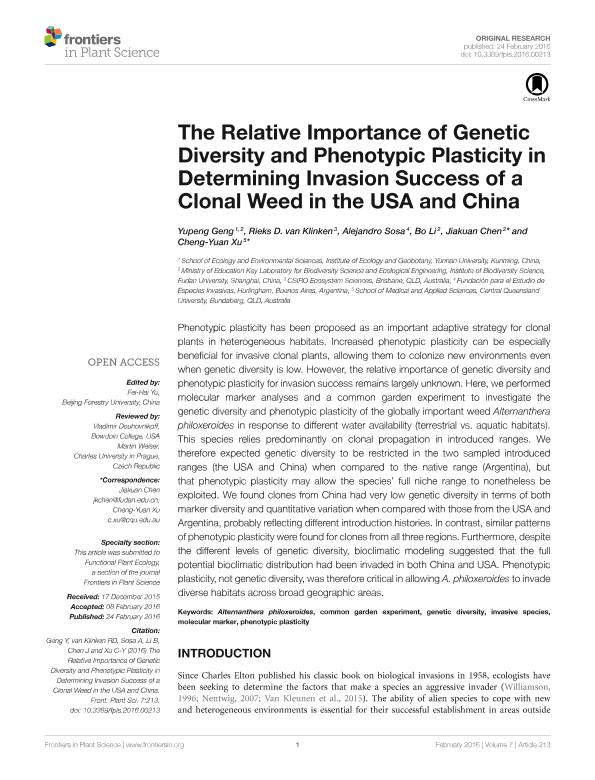Mostrar el registro sencillo del ítem
dc.contributor.author
Geng, Yupeng
dc.contributor.author
van Klinken, Rieks D.
dc.contributor.author
Sosa, Alejandro Joaquín

dc.contributor.author
Li, Bo
dc.contributor.author
Chen, Jiakuan
dc.contributor.author
Xu, Cheng Yuan
dc.date.available
2019-04-24T15:27:49Z
dc.date.issued
2016-02
dc.identifier.citation
Geng, Yupeng; van Klinken, Rieks D.; Sosa, Alejandro Joaquín; Li, Bo; Chen, Jiakuan; et al.; The relative importance of genetic diversity and phenotypic plasticity in determining invasion success of a clonal weed in the USA and China; Frontiers Media S.A.; Frontiers in Plant Science; 7; 2-2016; 1-13
dc.identifier.issn
1664-462X
dc.identifier.uri
http://hdl.handle.net/11336/74916
dc.description.abstract
Phenotypic plasticity has been proposed as an important adaptive strategy for clonal plants in heterogeneous habitats. Increased phenotypic plasticity can be especially beneficial for invasive clonal plants, allowing them to colonize new environments even when genetic diversity is low. However, the relative importance of genetic diversity and phenotypic plasticity for invasion success remains largely unknown. Here, we performed molecular marker analyses and a common garden experiment to investigate the genetic diversity and phenotypic plasticity of the globally important weed Alternanthera philoxeroides in response to different water availability (terrestrial vs. aquatic habitats). This species relies predominantly on clonal propagation in introduced ranges. We therefore expected genetic diversity to be restricted in the two sampled introduced ranges (the USA and China) when compared to the native range (Argentina), but that phenotypic plasticity may allow the species' full niche range to nonetheless be exploited. We found clones from China had very low genetic diversity in terms of both marker diversity and quantitative variation when compared with those from the USA and Argentina, probably reflecting different introduction histories. In contrast, similar patterns of phenotypic plasticity were found for clones from all three regions. Furthermore, despite the different levels of genetic diversity, bioclimatic modeling suggested that the full potential bioclimatic distribution had been invaded in both China and USA. Phenotypic plasticity, not genetic diversity, was therefore critical in allowing A. philoxeroides to invade diverse habitats across broad geographic areas.
dc.format
application/pdf
dc.language.iso
eng
dc.publisher
Frontiers Media S.A.
dc.rights
info:eu-repo/semantics/openAccess
dc.rights.uri
https://creativecommons.org/licenses/by-nc-sa/2.5/ar/
dc.subject
Alternanthera Philoxeroides
dc.subject
Common Garden Experiment
dc.subject
Genetic Diversity
dc.subject
Invasive Species
dc.subject
Molecular Marker
dc.subject
Phenotypic Plasticity
dc.subject.classification
Otras Ciencias Biológicas

dc.subject.classification
Ciencias Biológicas

dc.subject.classification
CIENCIAS NATURALES Y EXACTAS

dc.title
The relative importance of genetic diversity and phenotypic plasticity in determining invasion success of a clonal weed in the USA and China
dc.type
info:eu-repo/semantics/article
dc.type
info:ar-repo/semantics/artículo
dc.type
info:eu-repo/semantics/publishedVersion
dc.date.updated
2019-04-24T13:34:54Z
dc.journal.volume
7
dc.journal.pagination
1-13
dc.journal.pais
Suiza

dc.journal.ciudad
Lausana
dc.description.fil
Fil: Geng, Yupeng. Yunnan University; China. Fudan University; China
dc.description.fil
Fil: van Klinken, Rieks D.. Csiro Ecosystem Sciences; Australia
dc.description.fil
Fil: Sosa, Alejandro Joaquín. Consejo Nacional de Investigaciones Científicas y Técnicas; Argentina. Fundación para el Estudio de Especies Invasivas; Argentina
dc.description.fil
Fil: Li, Bo. Fudan University; China
dc.description.fil
Fil: Chen, Jiakuan. Central Queensland University; Australia
dc.description.fil
Fil: Xu, Cheng Yuan. Central Queensland University; Australia
dc.journal.title
Frontiers in Plant Science
dc.relation.alternativeid
info:eu-repo/semantics/altIdentifier/doi/https://dx.doi.org/10.3389/fpls.2016.00213
dc.relation.alternativeid
info:eu-repo/semantics/altIdentifier/url/https://www.frontiersin.org/articles/10.3389/fpls.2016.00213
Archivos asociados
